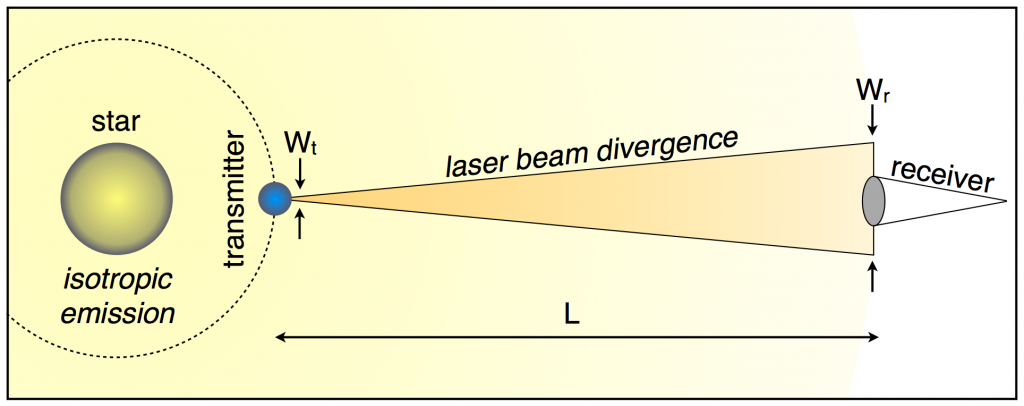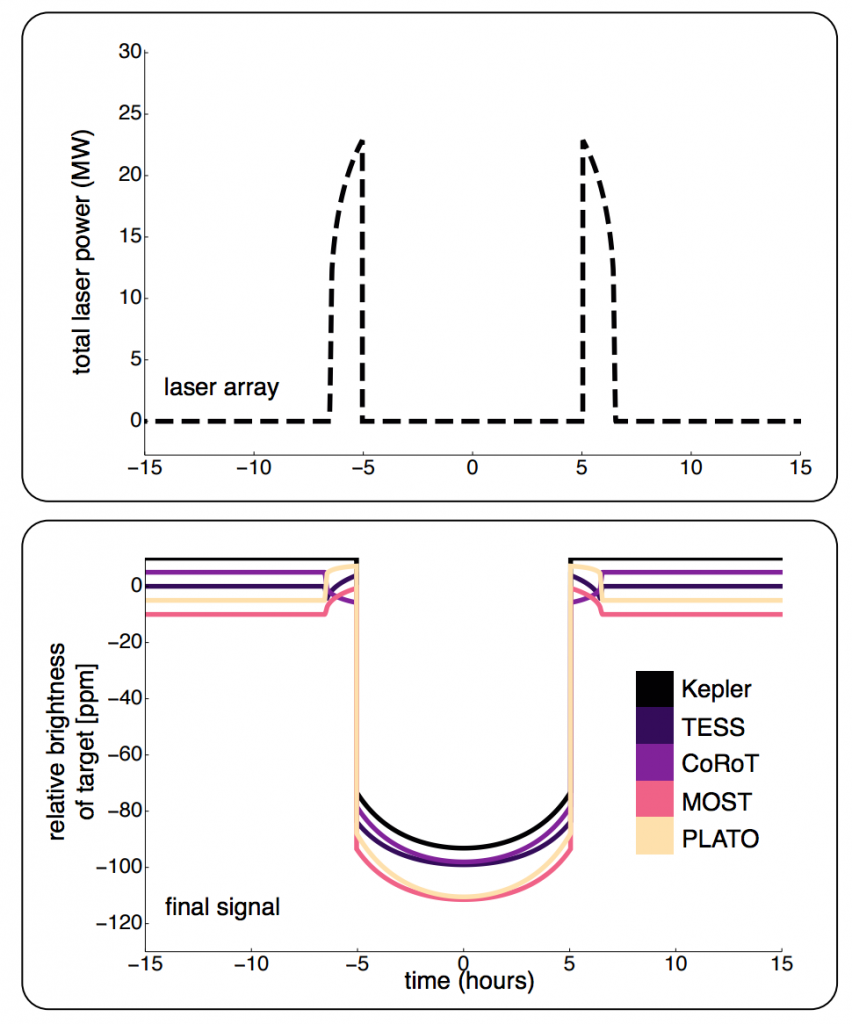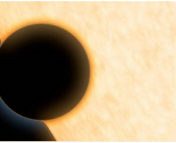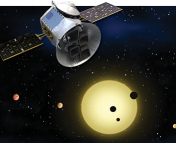Title: A Cloaking Device for Transiting Planets
Authors: David M. Kipping, Alex Teachey
First Author’s Institution: Columbia University
Status: Accepted to MNRAS
Have you ever trawled through the internet, through social media, online dating and current affairs, and thought “Yeah, these people are alright… but all I really want to do is just message a nice alien boy/girl/20 foot tall sentient slab of granite”. Well the good news is now we probably can, and at the same time we almost certainly shouldn’t.
Look down. No really, look down. What do you see?
Did you see it?
That’s right, it’s the Earth.
N.B. If you didn’t see the earth you may be either an acrobat, a bat or indoors.
Now go 500 billion miles straight up. (I’ll wait) Look down, and what do you see?
That’s right, it’s a dot.
N.B. If you didn’t see a dot you’re probably not the next generation of space telescopes.

The Earth. Credit: Me, just now

A dot (small red planet) next to a dot (big blue star). Credit: European Souther Observatory, a little while ago
You’re just about as far away from the Earth as you can be and still hope to see it directly. Yet if you look at a map of the Galaxy you’ve still barely moved.
To see any Earth-like planet much farther away you’ve got to be a little more clever. Luckily these planets are swinging around nice bright stars like our own (actually this is pretty unlucky, we’d be able to see the planet more easily if it wasn’t swamped by the light of the star). With some good fortune the systems lined up so that once an orbit the planet passes between us and the star, blocking out some of the star’s light and causing an incredibly underwhelming eclipse (the observed brightness only drops by about 0.01% depending on the planet).
All we can observe is the brightness of the star, and the way it changes. As the planet crosses into the path between us and the star the drop in brightness has a characteristic shape (see below). Kind of like what you’d get if you chopped a bathtub in half and looked at the cross section (shortly before your parents/landlord shouted at you) with sloping sides and a near flat bottom.

An example of a transit observation. As the planet moves across the star the observed brightness dips gradually (2), until the entire planet is in front of the star and the brightness is roughly constant (3). Credit: Hans Deeg
The slope of these sides can contain huge amounts of information, if we can make a good guess about how fast the planet is orbiting then the amount of time it takes for the planet to fully cross in front of the star can tell us it’s radius. More excitingly, for a brief period the thing casting the shadow isn’t the planet itself, but it’s atmosphere, and some telltale signals could give us a hint as to whether the planet is habitable (like a temperate atmosphere with some water vapor), or even habited (some molecules only “intelligent” life can create, like some greenhouse gases).
If this is all we can see of other planets, it’s not a huge leap to guess that this is about all they can see of us too. But what if we’re feeling a bit shy, and we want to hide ourselves away from prying eyes, can we somehow cover this signal? Surely it would take incalculable amounts of power, beaming fake signals out in all directions? That’s what the authors of this paper wondered, then they stopped wondering because they’d done it.

And I bet you thought firing a laser beam at someone is a terrible way to win at hide-and-seek… (From the paper)
Turns out, it’s actually pretty easy, for two reasons:
Firstly, this shadow is only visible when the Earth is directly in the line of sight between alien observers and the Sun. That means at any moment, only observers in one specific direction have even a chance to observe us.
Secondly, lasers. You may be familiar with lasers as prime tools for annoying cats and discovering ripples in the very fabric of the universe, but the strength of a laser comes not from a huge power output, it’s because all the power is focused in one very thin beam.

If it fools aliens, and it fools cats… Are cats aliens? Credit: House Cats
Seeing as observers only in a very small region could see us at any moment, we only need to beam light, equal to the amount the Earth’s shadow is blocking from the Sun, in a very specific direction and as far as our possible alien overlords can tell there’s no dip in the Sun’s light, no planet orbiting it and no need to draw up a nice new invasion plan.

Detailed numerical simulations of an alien invasion give us terrifying images like this Credit: Dave Mathis
How much power would be needed to do this, to send this signal half way across the galaxy. Not actually all that much. Just over 200MW, roughly one nuclear power plant‘s worth. And that’s pretty manageable (what global energy crisis?). If we only want to hide our atmosphere, or even only the signs of there being intelligent life on the planet it require even less power, as we only need to smooth out a few absorption lines.
All this is well and good, but I promised you broadcasting to aliens, not hiding away from them. And we could use this exact same idea to broadcast a signal so explicit they couldn’t possibly misinterpret it. You might think we could just flash a light on and off at them until they got the point, but the problem is actually persuading them it’s a message and not just some random physical phenomenon.
Try it now, flash a light at someone on and off repeatedly. Maybe a lecturer or a someone else sitting on your bus/plane/bathysphere. Whether you use carefully worded morse code or do it to a perfectly timed rendition of Flight of the Bumblebee, I guarantee you they’re not going to decode it as some meaningful message, they’ll just think some idiot shouldn’t have been given a flashlight.
So we need to think of something that can, 100% not be mistaken as random, not be interpreted by chance, not be glossed over as just one-of-those-things-that-happen. And the best way to do this is to create a signal that’s completely unphysical, that science just cannot explain without the intervention of at least marginally intelligent life.
A prime candidate for this is to take our transit, and alter it just enough that it couldn’t possibly be real. What if we took our nice, physical bathtub shaped shadow and beamed out just enough light to give it perfectly vertical sides, which would be both impossible as a transiting shadow, and really uncomfortable as a bath. Of course, we could also just make our transit in the shape of the bat-signal, but this is fine too I guess.

If we add a light source shaped like the dashed line to our transit, the observed shadow will look like one shown below (with different lines showing what would be seen by the equivalent of modern day telescopes). A transit like this could not possibly be caused by a planet and so the aliens are bound to call shenanigans. (From the paper)
Altering our transit like this is a clear signal to the rest of the galaxy that we’re here, it’s a achievable with modern day technology at a not-impossible cost and it’s, well, really cool.
So should we do it?
Never.
I’ll say that again:
Never.
Broadcasting our existence outside of our solar system, especially with methods like this which could reach a large fraction of our galaxy, would be one of the most irresponsible and short-sighted acts our already misguided and self-destructive species could ever commit.
Once the galaxy at large knows we’re here there’s no going back. Maybe aliens are all perfectly nice, maybe they could even raise up our society to new utopian heights (because that always goes well), but maybe they’re not.

Stephen Hawking is one of many prominent thinkers whose warned that reaching out to extra-terrestrial civilizations could be dangerous, and even irresponsible. Credit: Paul Alers
Imagine a colony of mice, living a fairy-tale life in the boughs of a tree, hidden from and untroubled by predators. Then imagine one of them works out how to poke a flag up through the foliage with a picture of a mouse and an arrow pointing down. Imagine a little later a much smaller colony of well-fed and slightly red-flecked owls living in that same tree.
Aliens are not necessarily bears, in that they may be much less scared of us than we are of them. They may not be out there at all, life may be so sparsely littered across the cosmos that this is all a moot point. And they might all be lovely and huggable if you can don’t mind all the extra arms.

Only a mother could love… Credit: Henrique Alvim Correa
But space is the unknown, what populates it is nigh-on unguessable and as exciting as it is to have the tools to unlock a door doesn’t always mean you should. This paper is not condoning us exposing ourselves to the cosmos nor necessarily concealing our presence, but as is true for so much of science, simply exploring a fascinating, if precipitous, idea.
Whether we should actively hide ourselves is a more difficult question, with no easy answer. But when the means to expose the many could rest in the hands of the few, be they grand humanitarians, celebrated scientists or just over-eager enthusiasts, shining a light could be a very dangerous proposition.




